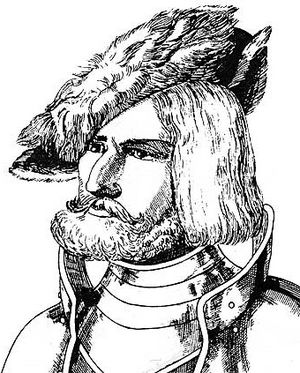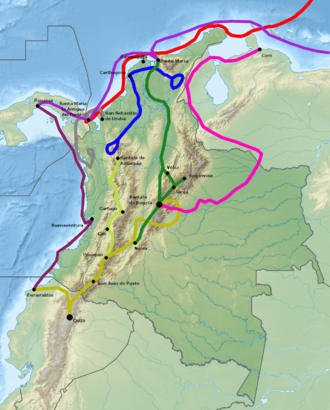Nikolaus Federmann facts for kids
Quick facts for kids
Nikolaus Federmann
|
|
|---|---|

Portrait of Nikolaus Federmann
|
|
| Born | ~1505 Ulm, Free Imperial City of Ulm
|
| Died | February 1542 (aged ~37) |
| Nationality | Swabian |
| Other names | Nicolás de Federmán |
| Occupation | Conquistador |
| Years active | 1529->1539 |
| Employer | Welser family of Augsburg Spanish Crown |
| Known for | Deputy leader of Klein Venedig Quest for El Dorado Spanish conquest of the Muisca |
|
Notable work
|
Indianische Historia. Ein schöne kurtzweilige Historia Niclaus Federmanns des Jüngern von Ulm erster raise (1557, post mortem) |
Nikolaus Federmann (also known as Nicolás Féderman) was a German explorer and conquistador. He lived from about 1505 to 1542. He played a big part in the early history of what is now Venezuela and Colombia.
Federmann was involved with a German banking family called the Welsers. They had a special agreement with the King of Spain to explore and settle parts of Venezuela. This area was known as "Little Venice" (Klein Venedig). Federmann also helped found the city of Bogotá.
Contents
Nikolaus Federmann's Life
Nikolaus Federmann was born in a city called Ulm in Germany around 1505. In 1529, the Welser family sent him to the Americas. He traveled with settlers and miners from Spain to a place called Coro in Venezuela.
When he arrived, the governor of the colony, Ambrosius Ehinger, made Federmann his assistant. In July 1530, Federmann became the temporary leader of the "Little Venice" colony. This happened because Governor Ehinger had to go to another island for health reasons.
Early Expeditions
In September 1530, Federmann decided to go on an expedition without official permission. He explored the northern part of the Orinoco river basin. He was looking for the "South Sea," which is now known as the Pacific Ocean. He hoped to find a new trade route to Asia.
Federmann took 110 foot soldiers, 16 mounted soldiers, and 100 native guides with him. He did not find the Pacific Ocean. But he returned to Coro in March 1531 with a lot of gold. Because he went on this trip without permission, the governor sent him back to Europe for four years.
While he was back in Germany, Federmann wrote a book. It was called Indianische Historia. This book was published later, in 1557.
Journey to La Guajira
After returning to the Americas, Federmann left Coro again. He traveled to the area known today as La Guajira in northern Colombia. One of his goals was to find pearls along the Caribbean coast.
Some stories say he founded the city of Riohacha in 1535. However, he did not manage to get native divers to search for pearls. He also failed to start a city he wanted to name "Ulma," after his hometown. Federmann returned to Coro in February 1536 without setting up a permanent settlement.
Founding Bogotá
From Coro, Federmann traveled along the eastern side of the Eastern Andes Mountains in Colombia. He went through the flat grasslands called the Llanos. He followed a salt trade route and eventually reached the Muisca people's territory.
This area was already mostly taken over by another Spanish conquistador, Gonzalo Jiménez de Quesada. Jiménez de Quesada was not happy to see another explorer arrive. Federmann met with Jiménez de Quesada and Sebastián de Belalcázar, another conquistador.
Together, these three leaders officially re-founded the city of Bogotá on April 27, 1539. Jiménez de Quesada had tried to start Bogotá earlier, but he had not followed all the official rules. The three leaders met in a place called Bosa. They decided to travel back to Spain to ask the King for rewards for their explorations.
Gonzalo Jiménez de Quesada left his brother, Hernán Pérez de Quesada, in charge of the new territory. He also chose the first mayor and council for Bogotá. Many soldiers from Federmann's and Belalcázar's groups decided to stay in Bogotá. This helped make Jiménez de Quesada's army stronger.
Federmann had not found the legendary golden city of El Dorado. In mid-May 1539, he returned to the Caribbean coast. From there, he sailed to Spain from Cartagena. Records say they arrived in Spain in November 1539.
Return to Europe
Back in Europe, Federmann faced problems with the Welser family. They said he had broken his agreements and kept money that belonged to them. The Welser family asked for a lot of money and emeralds from him.
Since Federmann could not pay, he spent some time in prison. He tried to defend himself in court. He also said that the Welser family had not paid their taxes to the Spanish King. In October 1541, Federmann finally reached an agreement. The Welser family dropped their money demands, and Federmann gave up his land rights in the new territories.
Nikolaus Federmann died in February 1542 in a city called Valladolid in Spain.
Writings
- Indianische Historia. Ein schöne kurtzweilige Historia Niclaus Federmanns des Jüngern von Ulm erster raise (This book is about his first expedition and was published in 1557).
Interesting Facts
- There is a statue of Nikolaus Federmann in a park in Rio Hacha, Colombia. It is one of the few statues of conquistadors that still stands.
- A neighborhood in Bogotá is named Nicolás de Federmán. This is the Spanish version of his name.
See also
 In Spanish: Nicolás Federmann para niños
In Spanish: Nicolás Federmann para niños


